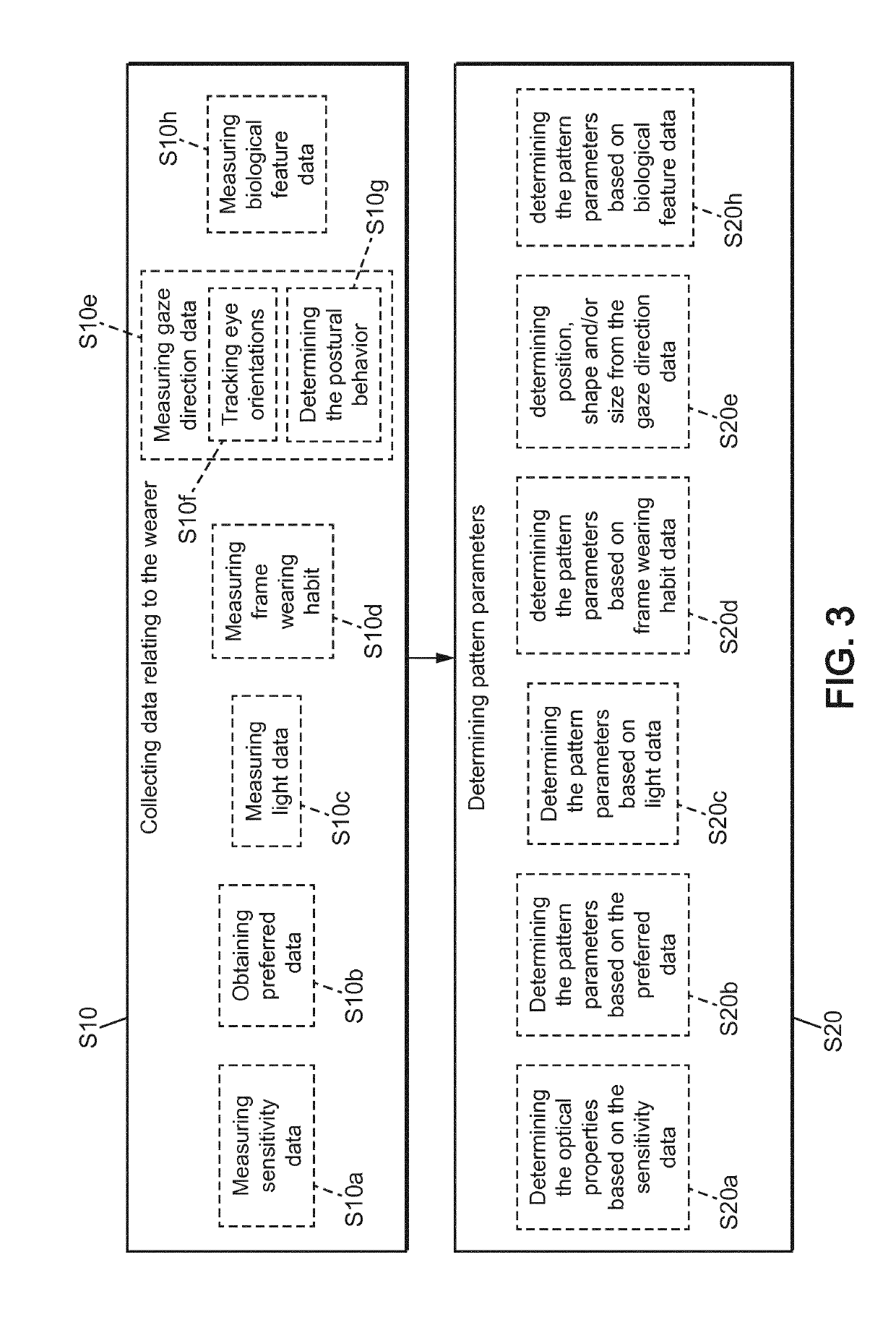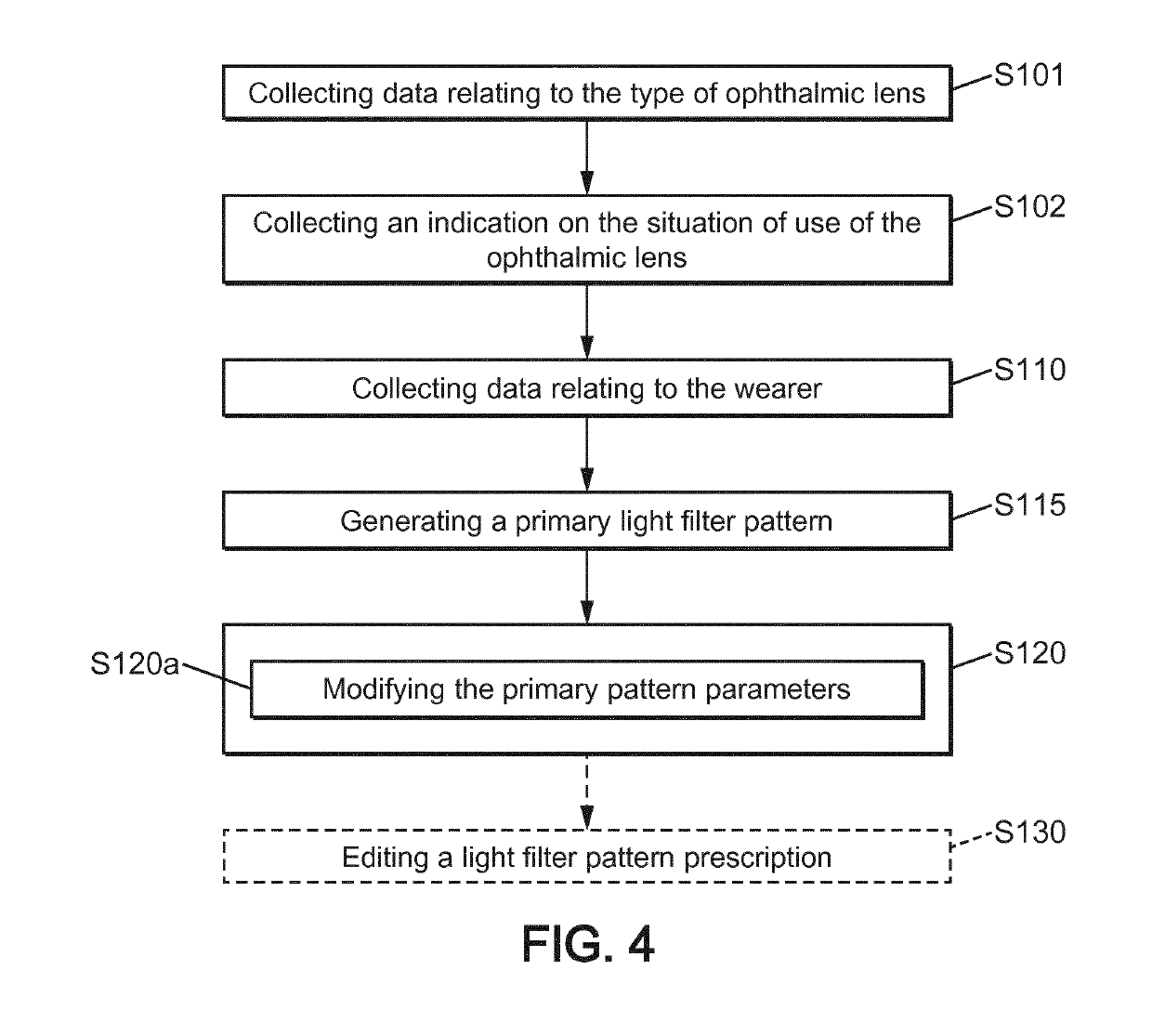Method for determining an ophthalmic lens and associated ophthalmic lens
- Summary
- Abstract
- Description
- Claims
- Application Information
AI Technical Summary
Benefits of technology
Problems solved by technology
Method used
Image
Examples
example 2
A Progressive Ophthalmic Lens Adapted for New Progressive Lens Wearers or for Vision Stabilization
[0113]In step S115a, a clear progressive lens defined by a design of the correction properties is selected based on the wearer's prescription D2 and the basic intended purpose D4.
[0114]In step S115b, a primary filter pattern comprising first, second and third light-filtering zones respectively corresponding to the far field zone, the near field zone and the transition zone, is generated based on the progressive lens design choice and the frame size. A fourth primary light-filtering zone corresponding to the zone outside of the first to third light-filtering zones is also generated. The optical properties of the first to third primary light-filtering zones are set to be at a predetermined value corresponding to a high transmission of light for all wavelengths. The optical properties of the fourth primary light-filtering zone is set to be at a predetermined value corresponding to a low tr...
example 3
Ophthalmic Lens Adapted for Night Driving
[0116]In step S115a, a type of ophthalmic lens is selected based on the basic intended purpose D4, the correction properties D5 and optionally, on the type and / or size of the frame, design of correction properties and a type of tint.
[0117]In step S115b, a primary filter comprising five primary light-filtering zones. The size, position and shape of each of the five primary light-filtering zones are determined based on the average positions of the view field of a standard population looking at the each of the two side mirrors, the rear mirror, the instrument panel and straight forward through the ophthalmic lens that is used when the wearer is looking at the road is generated, respectively.
[0118]In step S120, the wearer is seated in a car or is looking at a virtual scene representing the_environment of the car, for example using a virtual reality headset or a display. The wearer is asked to perform the five following tasks: look at the left sid...
example 4
Ophthalmic Lens Adapted for Daylight Driving
[0119]In step S115a, a type of ophthalmic lens is selected based on the basic intended purpose D4, the correction properties D5 and optionally, on the type and / or size of the frame, design of correction properties.
[0120]In step S115b, a primary filter comprising two primary light-filtering zones are generated. The shape, size and position of the first primary light-filtering zone are determined based on the average position of the upper part of the scene corresponding to the viewing field through the windshield and to the reflective dashboard. The optical properties of the first primary light-filtering zone are set to correspond to a polarizing filter whose polarization axis is set to attenuate reflection on the road or on the reflective dashboard. The second primary light-filtering zone corresponds to the complementary part of the first primary light-filtering zone on the ophthalmic lens. The optical properties of the second primary light...
PUM
 Login to View More
Login to View More Abstract
Description
Claims
Application Information
 Login to View More
Login to View More - R&D
- Intellectual Property
- Life Sciences
- Materials
- Tech Scout
- Unparalleled Data Quality
- Higher Quality Content
- 60% Fewer Hallucinations
Browse by: Latest US Patents, China's latest patents, Technical Efficacy Thesaurus, Application Domain, Technology Topic, Popular Technical Reports.
© 2025 PatSnap. All rights reserved.Legal|Privacy policy|Modern Slavery Act Transparency Statement|Sitemap|About US| Contact US: help@patsnap.com



